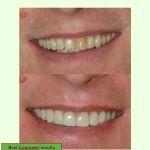
- understanding-why-tooth-sensitivity-occurs-after-filling
- common-causes-of-tooth-sensitivity-after-filling
- personal-experiences-with-post-filling-sensitivity
- how-to-manage-and-reduce-sensitivity-after-filling
- expert-opinions-on-sensitivity-after-dental-fillings
- find-best-relief-products-at-dentistry-toothtruth
1. Understanding Why Tooth Sensitivity Occurs After Filling
1.1. The Basics: What Happens During a Dental Filling?
Dental fillings are a standard treatment for cavities, but many patients are surprised to feel sensitivity after the procedure. This sensitivity is a common and often temporary reaction, but understanding its root causes is the first step to feeling better. The phrase “causes of tooth sensitivity after filling” is a frequent search because so many people experience discomfort that they weren’t expecting.
1.2. Normal vs. Concerning Sensitivity
For most people, mild sensitivity to hot, cold, or pressure is normal for a few days after a filling. However, when pain persists or worsens, it’s important to dig deeper into potential underlying causes and consider professional evaluation.
2. Common Causes of Tooth Sensitivity After Filling
2.1. Pulp Irritation from Drilling or Materials
One of the main causes of tooth sensitivity after filling is irritation of the tooth’s pulp during the procedure. The heat and vibration from dental tools, or even the chemicals in certain filling materials, can temporarily upset the sensitive nerve inside your tooth.
2.2. Bite Alignment and High Fillings
Sometimes, if a filling is too high or alters your bite, your tooth may feel sensitive every time you chew. This mechanical issue can often be fixed quickly by your dentist with a minor adjustment.
2.3. Type of Filling Material
Not all fillings are the same. Some people find that composite (white) fillings cause more sensitivity than traditional amalgam fillings, especially in deeper cavities. Sensitivity after dental filling may also be linked to how the material reacts with your natural tooth structure.
2.4. Underlying Issues: Hidden Decay or Micro-Cracks
If the cavity was deep or close to the nerve, or if there’s hidden decay or small cracks in the tooth, sensitivity can linger longer. These underlying problems sometimes require additional care or even a root canal in rare cases.
2.5. Temporary Inflammation vs. Infection
It’s important to distinguish between simple inflammation after dental work and signs of infection. If your tooth throbs or is extremely sensitive for more than a week, infection could be the cause and needs prompt attention.
3. Personal Experiences with Post-Filling Sensitivity
3.1. Real Stories from Patients
Many people have shared their stories online about dealing with tooth sensitivity after filling. For example, one individual described sharp pain when drinking cold water days after a filling, only to discover their bite was slightly off. Another case involved lingering sensitivity for weeks, which resolved after switching to a toothpaste for sensitive teeth.
3.2. Popular Cases from Social Media
Recently, a well-known dental health forum featured a thread where dozens discussed their own “post-filling sensitivity” episodes—some resolved with minor adjustments, while others needed additional dental visits. These community stories highlight just how common and fixable this problem can be.
3.3. The Human Side: How Patients Really Feel
Anxiety about dental procedures can make sensitivity feel even worse. One user wrote about feeling frustrated and worried after their third filling, questioning if something was seriously wrong. Reading similar experiences helped them feel reassured and empowered to seek professional advice.
4. How to Manage and Reduce Sensitivity After Filling
4.1. Home Remedies and Oral Care Adjustments
For mild cases, using toothpaste for sensitive teeth, avoiding extremely hot or cold foods, and practicing gentle brushing can speed up recovery. Many patients find improvement within days by following these simple steps.
4.2. When to Contact Your Dentist
If sensitivity lingers beyond a week or is severe, it’s crucial to reach out to your dentist. Persistent pain could mean a high filling, hidden decay, or even early infection—all situations that are much easier to address with professional care.
4.3. The Role of Patience and Communication
Sometimes, the best thing you can do is give your tooth a bit of time to settle. However, always keep your dentist informed of any changes or persistent issues.
5. Expert Opinions on Sensitivity After Dental Fillings
5.1. What Dentists Want You to Know
Dental professionals emphasize that most post-filling sensitivity is temporary and can be managed. However, they stress the importance of not ignoring severe or prolonged symptoms. Your dentist can check your bite, review the filling, and ensure no other issues are hiding beneath the surface.
5.2. Avoiding Future Sensitivity
Maintaining good oral hygiene, choosing experienced dentists, and communicating any dental sensitivities up front can help minimize risks for future fillings. Sometimes, requesting a different filling material or technique makes a big difference for those prone to sensitive teeth.
5.3. The Importance of Professional Guidance
While online advice and home care help many, nothing replaces the value of a professional opinion. For any doubts or persistent pain, consulting a dental expert is always the wisest move.
6. Find Best Relief Products at Dentistry Toothtruth
6.1. Solutions Tailored to Sensitive Teeth
For anyone struggling with the causes of tooth sensitivity after filling, Dentistry Toothtruth offers recommendations for products like sensitive toothpaste, oral gels, and mouth rinses. Their expert insights and user reviews help you find safe and effective options for relief.
6.2. Trusted Resources and Professional Support
At Dentistry Toothtruth, you can also find helpful articles, support for common dental problems, and professional guidance when over-the-counter solutions aren’t enough. It’s a reliable partner for anyone wanting to care for their teeth with confidence after a filling.







 Springfield Dentures and Implants4.0 (69 review)
Springfield Dentures and Implants4.0 (69 review) A Z Dental3.0 (41 review)
A Z Dental3.0 (41 review) Forest Ridge Family Dentistry5.0 (175 review)
Forest Ridge Family Dentistry5.0 (175 review) Motto Clear Aligners0.0 (0 review)
Motto Clear Aligners0.0 (0 review) Beck Dental Center4.0 (34 review)
Beck Dental Center4.0 (34 review) Celebrate Dental & Braces4.0 (724 review)
Celebrate Dental & Braces4.0 (724 review) The Importance of Oral Health Education During Pregnancy for a Healthy Pregnancy
The Importance of Oral Health Education During Pregnancy for a Healthy Pregnancy Best Tips for Brushing Your Teeth Properly for Healthy Gums: Essential Techniques for Oral Health
Best Tips for Brushing Your Teeth Properly for Healthy Gums: Essential Techniques for Oral Health Why Skipping Dental Checkups Can Lead to Bigger Oral Health Problems
Why Skipping Dental Checkups Can Lead to Bigger Oral Health Problems Advantages of Porcelain Dental Restorations
Advantages of Porcelain Dental Restorations How Can Diabetes Cause Tooth and Gum Problems? Preventing and Managing Oral Health Issues
How Can Diabetes Cause Tooth and Gum Problems? Preventing and Managing Oral Health Issues Healthy Habits for Promoting Good Oral Health and Hygiene: Tips for a Healthy Smile
Healthy Habits for Promoting Good Oral Health and Hygiene: Tips for a Healthy Smile